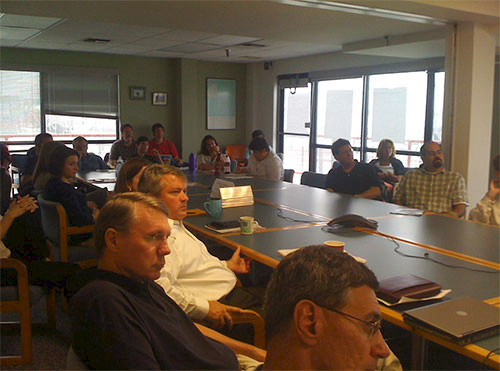Discussion following Margaret Palmer and Lisa Wainger seminar on Evidence-Based Restoration: Promoting Successful Restoration through Effective Monitoring and Adaptive Management
Bill Dennison ·This blog post discusses the seminar given by Margaret Palmer of the Chesapeake Biological Laboratory, at the IAN Seminar Series on September 30, 2010.
This seminar was presented by Dr. Margaret Palmer, but both Drs. Palmer and Wainger participated in the discussion following the seminar.
The issue that measuring the effectiveness of restoration projects is fundamentally different than tracking ecosystem health through monitoring efforts was discussed. The need for geographically targeted monitoring with rate measurements rather than static measures was a central theme of the seminar, and the presenters made a case that monitoring all restoration projects is likely prohibitive, so choosing representative projects and monitoring those sites well is a better strategy. The other point that was discussed was the need to always monitor the implementation of the stream restoration (Did they do what they said they were going to do? and Did they put it in right?). Recommendations to the restoration groups, particularly the Chesapeake Restoration 2010 Trust Fund by the State of Maryland, were to pool monitoring resources and not try to monitor every small project, except for compliance monitoring. The underlying philosophy for restoration monitoring should be to establish Best Management Practices and use that new knowledge to better design and locate future restoration projects.

The question of how long the 'pre' and 'post' project monitoring should take place was raised. The importance of seasonality was stressed, thus a one year minimum was suggested, with the caveat that unusual hydrology (e.g., record wet or dry conditions) could necessitate longer monitoring periods.
The reconnection between the stream bed and the adjacent floodplain was an issue that came up several times in the discussion. The connectivity at the landscape scale was a common theme and the added value of having the streams include a mosaic of wetlands included the increased effectiveness of nitrogen and sediment removal. The connectivity of bugs vs. plants is different, and increasing connectivity could also provide disease vectors or remove barriers to exotic species.
The spatial variability issue was discussed, particularly with regard to the need to match the sampling scale to the scale of the spatial variability. Putting this concept into practice could include picking a few similar sites and test whether or not a restoration technique is working. There were a few 'short cuts' that can aid in monitoring, for example, measure discharge as a proxy for nitrogen and sediment loads, by using the discharge/loading relationships developed at a few sentinel sites. Since discharge can be monitored with simple pressure transducers, the complete hydrograph of streams can be obtained relatively easily. Analysis of this hydrograph can be used to establish whether or not the spikes from rainfall events have been dampened by the restoration project, for example.

The location of stream restoration projects within the watershed was discussed. The point was made that nitrogen reductions downstream are difficult, so upper watershed projects to minimize the nitrogen making into the stream in the first place makes sense. The efficiencies of stormwater projects vs. stream restoration projects need to be analyzed. The data suggest that significant nitrogen reductions can be obtained by grassy ditches or swales in small streams, for example. So the cost-benefit analysis of which practices across the entire landscape will deliver the best overall results is a crucial future research need. The effectiveness of a series of small projects ("micro-BMPs") is a big unknown that needs to be addressed.
Climate change is predicted to accentuate the droughts punctuated by short intense precipitation in the Mid-Atlantic region. Building climate change considerations into ecosystem restoration is an emerging challenge. The presenters made the point that the key factor to aim for is ecosystem resilience (the ability the ecosystem to function following a perturbation). It could be that there will be a need to prioritize restoration and we may be unable to provide everything to everyone.
Another somewhat heretical concept was raised regarding restoration monitoring. The concept underlying much of monitoring was the desire to maintain or reestablish biodiversity. The alternative is to restore key ecological processes (e.g., sediment or nutrient removal), and to focus on functional rather than the structural elements. The limiting factor needs to be identified and if water quality is the limiting factor for reestablishing the benthic macroinvertebrates in streams, then the stream bed characteristics (cobble vs. sand) are not going to help bring these organisms back to a degraded stream.
The size of the restoration effort was discussed, and the concept of measuring stream restoration in terms of square feet (or meters) vs. linear feet (or meters) was suggested. In this way, the landscape connectivity could be incorporated into the restoration metrics. The time scale was also discussed and a question was raised about how long a series of step pools could retain sediments. It could be that the step pools only serve as a temporary sediment trap and a large flow event delivers the sediment downstream eventually. The design of restoration projects needs to consider whether or not the 1 in 10 year flow event or rather the annual flow events are incorporated.
The Phase II of the Watershed Implementation Programs (WIPs) is where geographically explicit plans need to be developed and it will be in this phase that the consideration of stream restoration site selection comes into play. The constraints of conducting stream restoration on private lands and the relatively fixed cost for design (approximately $100K each), regardless of size promotes the use of large restoration projects on public lands. It was noted that this may not be the optimal strategy for watershed protection, and a careful economic analysis is needed.
About the author
Bill Dennison

Dr. Bill Dennison is a Professor of Marine Science and Vice President for Science Application at the University of Maryland Center for Environmental Science.